Complete Solutions to Exercises of chapter FLUID MECHANICS of Class 11 book with complete answers and questions
| Class 11 | PHYSICS |
| Chapter | FLUID MECHANICS |
| CP SINGH | Exercises |
| Number Of Questions | 93 |
| Academic Year | 2023-24 |
In making an alloy, a substance of specific gravity `s_(1)` and mass `m_(1)` is mixed with another substance of specific gravity of the alloy is
View SolutionA liquid can easily change its shape but a solid can not because
View SolutionConsider the equations
`P=Lim_(/_\srarr0)F/(/_\S) and P_1-P_2=rhogz`
In an elevator acceleratin upward
View SolutionThe three vessels shown in figure have same base area. Equal volumes of a liquid are poured in the thre vessels. The force on the base will be
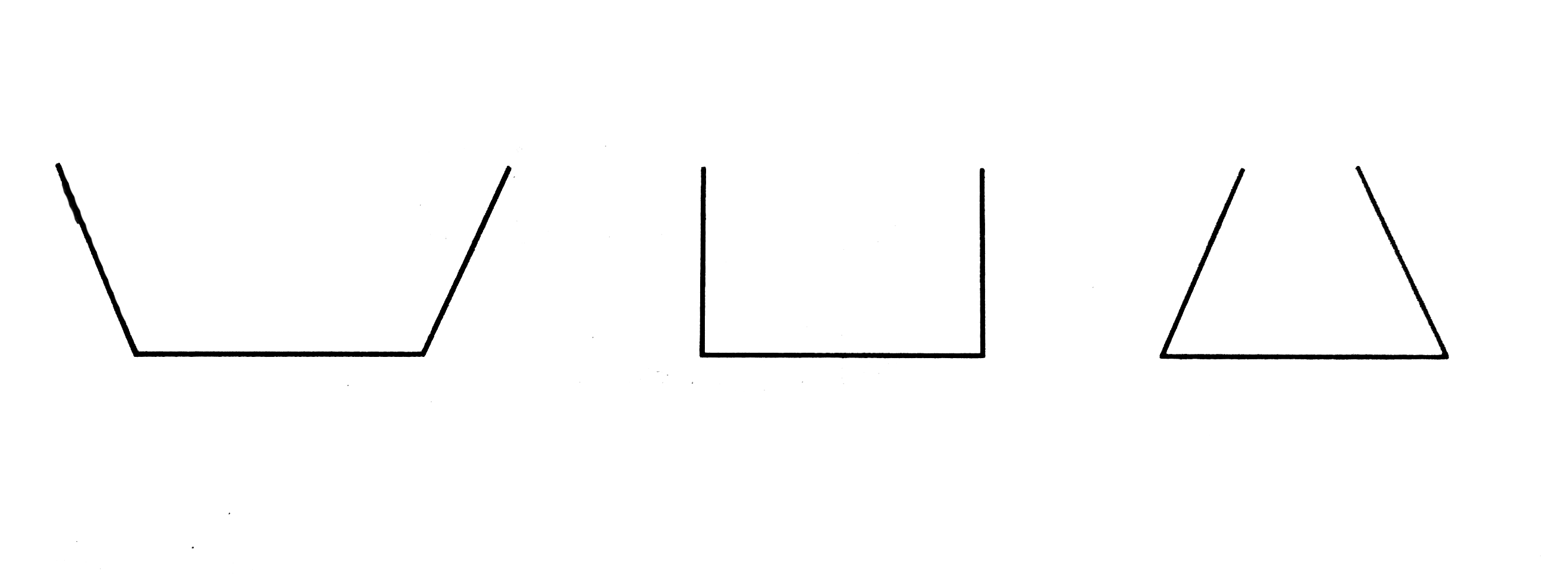
View SolutionEqual mass of three liquids are kept in three identical cuylindrical vessels A, B and C. the densities are `rho_A, rho_B, rho_C` with `rho_Altrho_Bltrho_C`. The force on the base will be
View SolutionFigure shows a siphon. The liquid shown in water. The pressure difference `P_B-P_A` between the points A and B is
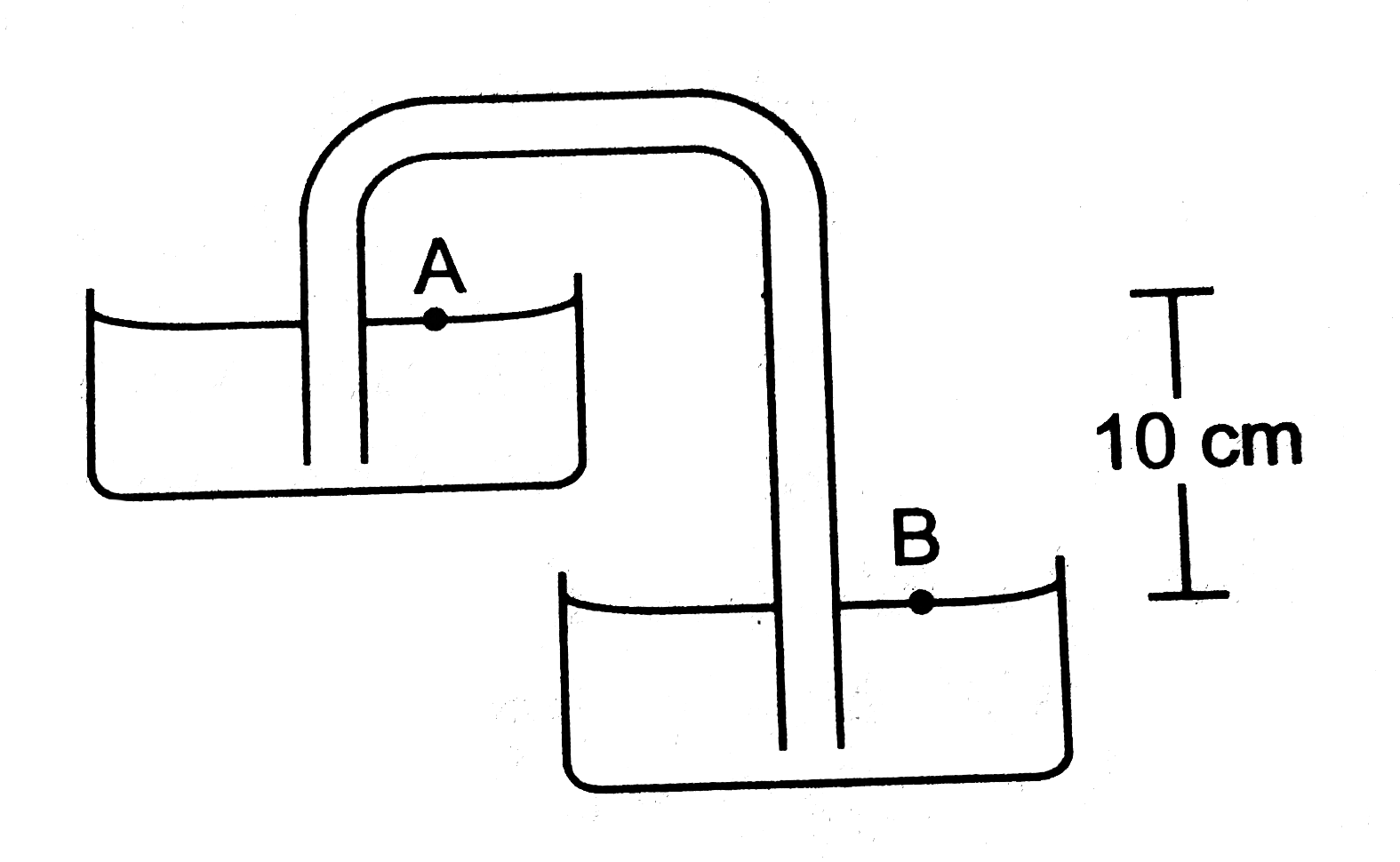
View SolutionA beaker containing a liquid is kept inside a big closed jar. If the air inside the jar is continuously pumped out, the pressure in the liquid near the bottom of the liquid will
View SolutionIf pressure at half the depth of a lake is equal to 2//3 pressure at the bottom of the lake then what is the depth of the lake ?
View SolutionA vertical `U` tube of uniform cross section contains mercury in both of its arms. A glycerine `(d=1.3g//cm^(3))` column of length `10 cm` is introduced into one of the arms. Oil of density `0.8g//cm^(3)` is poured in the other arm until the upper surfaces of the oil and glycerine are in the same horizontal level. Find the length of oil column. Densit of mercury is `13.6g//cm^(3)`.
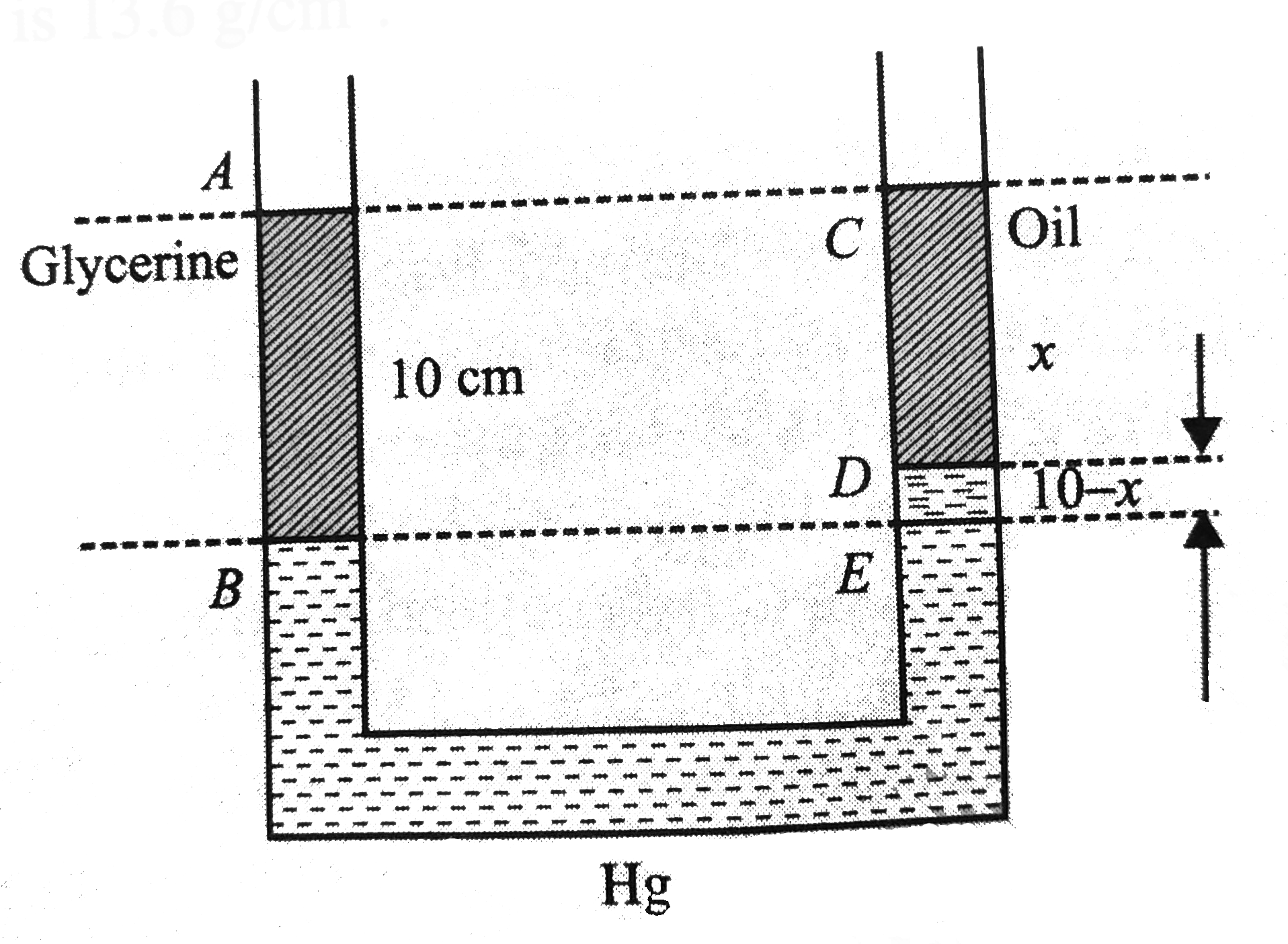
View SolutionIn a hydraulic press the small cylinder has a diameter of `'d_1' cm`, while the large piston has a diameter of `'d_2' cm`. If a force `'F_1'` is applied to a small piston, the force on the large piston `'F_2'` is given by.
View SolutionAn inverted bell lying at the bottom of a lake `47.6 m` deep has `50 cm^3` of air trapped in it. The bell is brought to the surface of the lake. The volume of the trapped air will be (atmospheric pressure `= 70 cm` of `Hg` and density of `Hg = 13.6 g//cm^3`).
View SolutionThe height to which a cylindrical vessel be filled with a homogenous liquid, to make the average force with which the liquid presses the side of the vessel equal to the force exerted by the liquid on the bottom of the vessel, is equal to.
View SolutionA triangular lamina of area `A` and height `h` is immersed in a liquid of density `rho` in a vertical plane with its base on the surface of the liquid. The thrust on the lamina is.
View SolutionBy sucking a straw a student can reduce the pressure in his lungs to `750 mm` of `Hg ("density")= 13.6 kg//cm^(3))` Using the straw, he can drink water from a glass up to a maximum depth of :
View SolutionTwo communicating vessels contain mercury. The diameter of one vessel in n times larger then the diameter of the other. A column of water of height h is poured into the left vessel. The mercury level will rise in the right hand vessel (s = relative density of mercury and `rho` = density of water) by
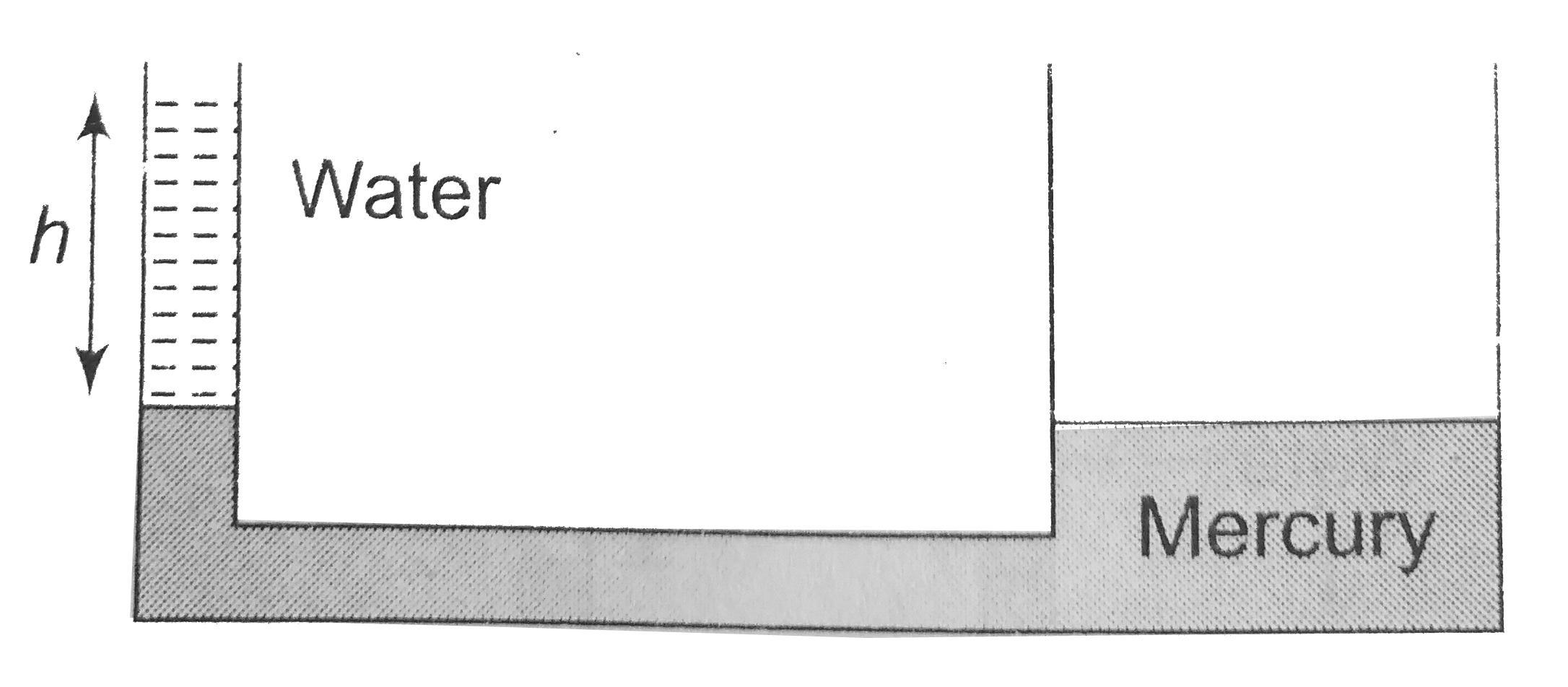
View SolutionSuppose the pressure at the surface of mercury in as barometer tube is `P_1` and the pressure at the surface of mercury in the cup is `P_2`.
View SolutionTo construct a barometer, a tube of length 1m is filled completely with mercury and is inverted ina mercury cup. The barometer reading on a particular day is 76 cm. Suppose a 1m tube is filled with mercury up to 76 cm and then closed by a cork. It is inverted in a mercury cup and the cork is removed. It is inverted in a mercury column in the tube over the surface in the cup will be
View SolutionThe vessel shown in the figure has a two sections of areas of cross-section `A_1` and `A_2`. A liquid of density `rho` fills both th sections, up to a height `h` in each Neglect atmospheric pressure. Choose the wrong option.
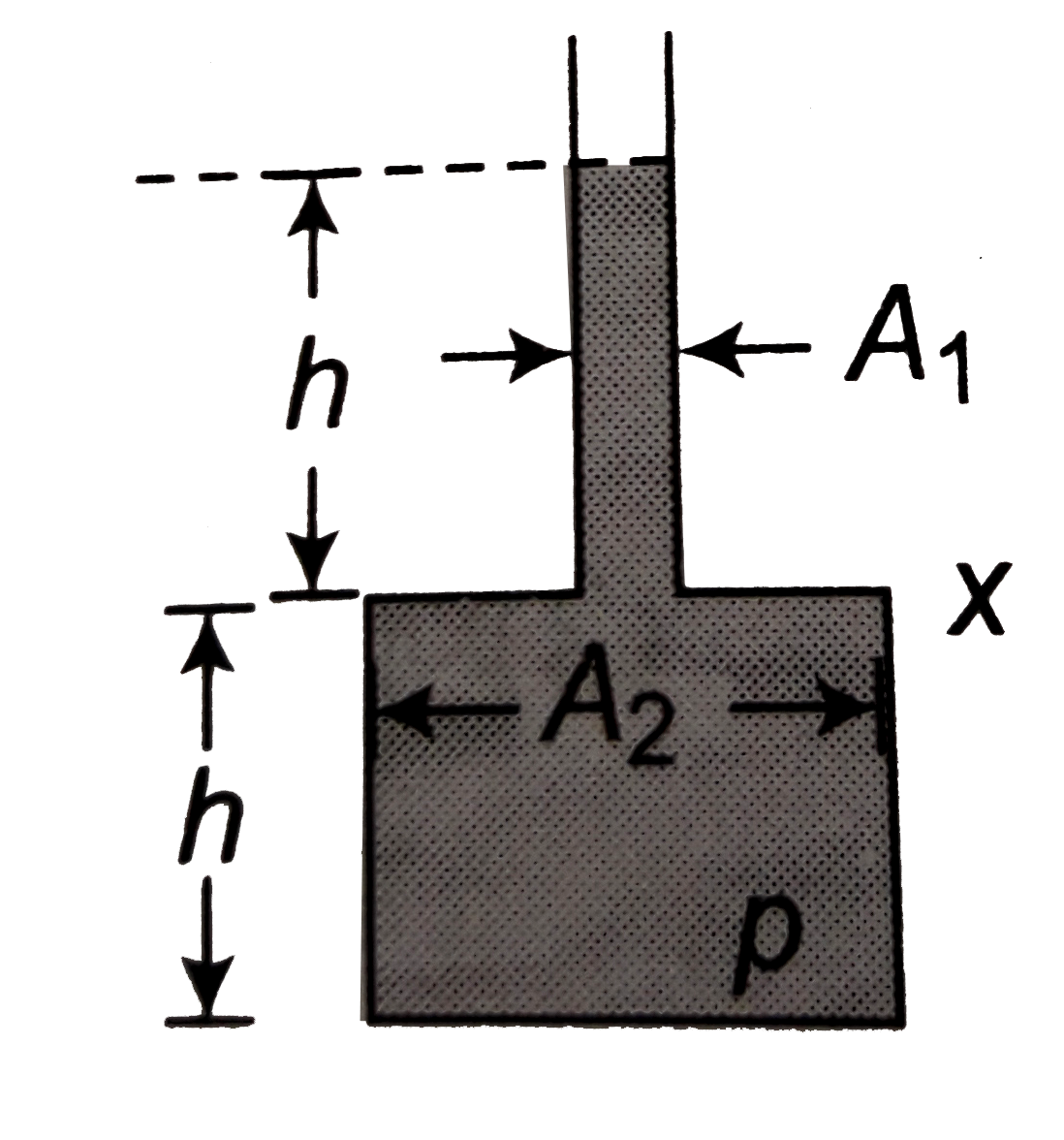 .
.
View SolutionA beaker containing a liquid of density `rho` moves up with an acceleration `a`. The pressure due to the liquid at a depth h below the free surface of the liquid is.
View SolutionThe pressure in a liquid at two points in the same horizontal plane are equal. Consider an elevator accelerating upward and a car accelerating on a horizontal road. The above statement is correct in
View SolutionA barometer kept in an elevator accelerating upward reads 76 cm. The air pressure in the elevator is
View SolutionA block of aluminium of mass `1 kg` and volume `3.6 xx 10^-4 m^3` is suspended from a string and then completely immersed in a container of water. The decrease in tension in the string after immersion is.
View SolutionA closed cubical box is completely filled with water and is accelerated horizontally towards right with an acceleration a. The resultant normal force by the water on the top of the box.
View SolutionA U-tube containing a liquid is accelerated horizontally with a constant acceleration `a_0`. If the separation between the vertical limbs is l find the difference in the heights of the liquid in the two arms.
View SolutionA sealed tank containing a liquid of density `rho` moves with horizontal acceleration a as shown in the figure. The difference in pressure between two points `A` and `B` will be
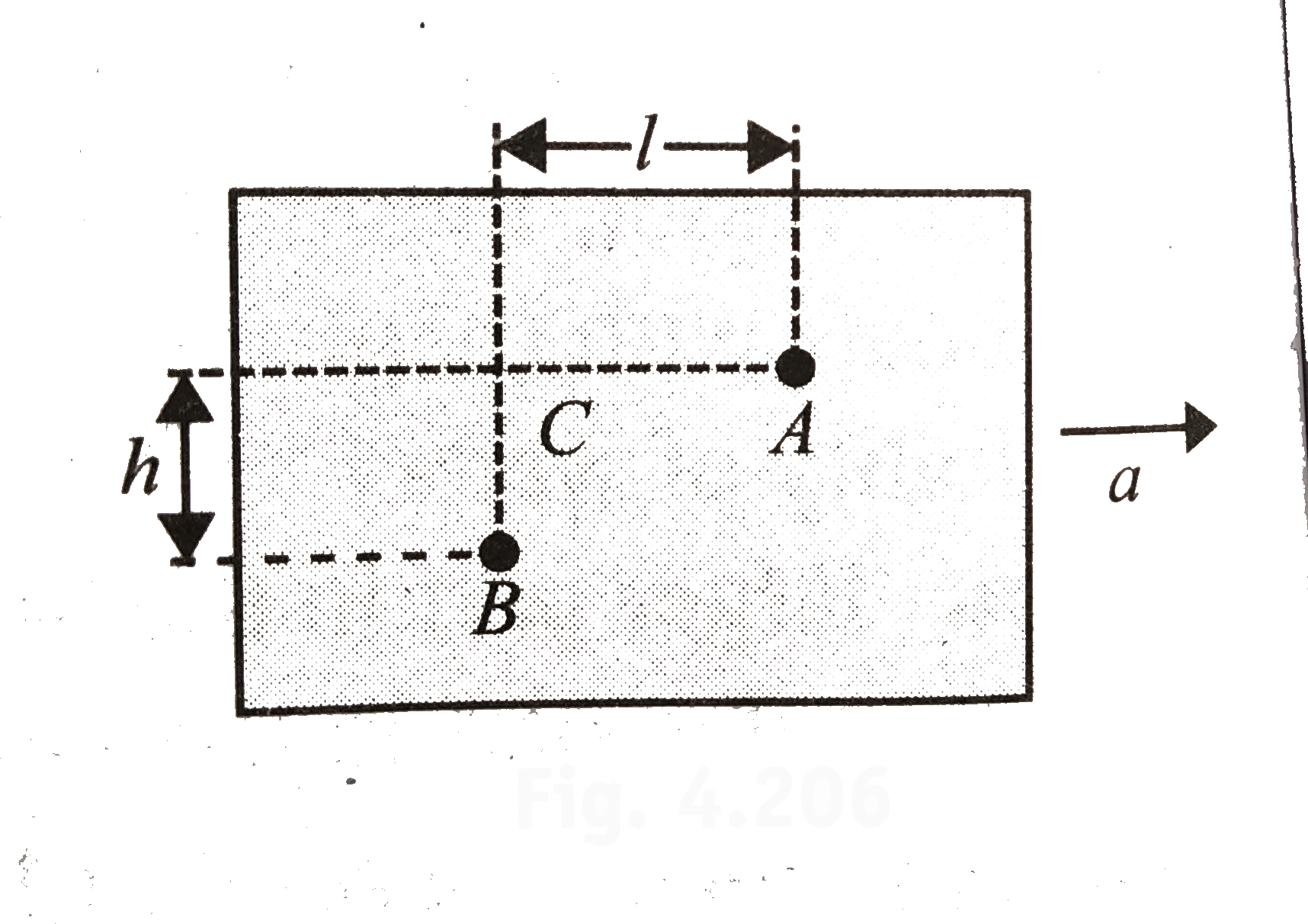
View SolutionThe `U`-tube shown in the figure has a uniform cross section. A liquid is filled up to heights `h_(1)` and `h_(2)` in the two arms and they are allowed to move. Neglecting viscosity and surface tension, find the state of the liquid when the levels equalize in the two arms. Find the correct statement.
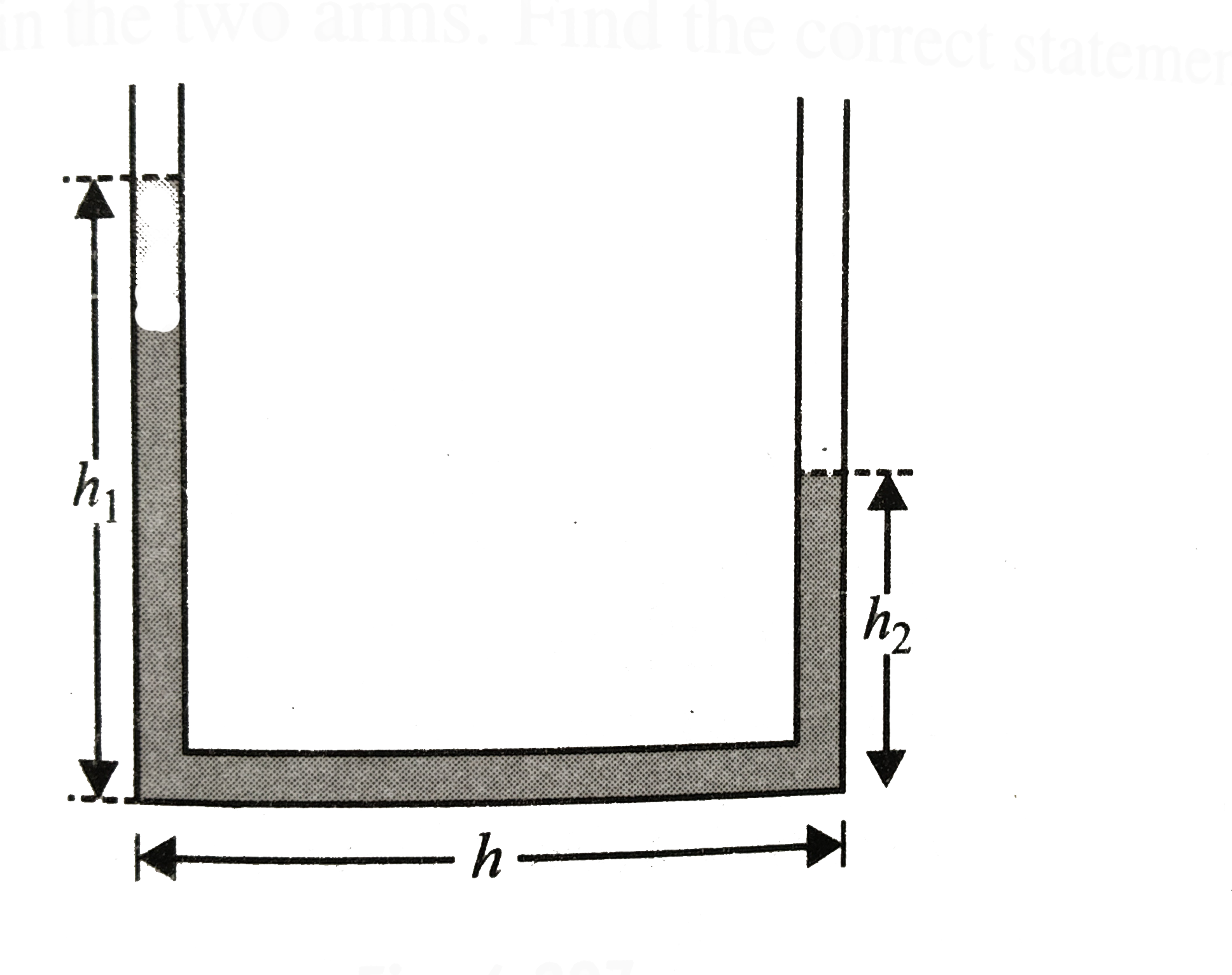
View SolutionA vertical `U-tube` contains a liquid. The total length of the liquid column inside the tibe is `1`. When the liquid is in equilibrium, the liquid surface in one of the arms of the `U-tube` is pushed down slightly and released. The entire liquid column will undergo a periodic motion.
View SolutionA solid sphere of density `eta (gt 1)` times lighter than water is suspended in a water tank by a string tied to its base as shown in fig. if the mass of the sphere is `m` then the tension in the string is given by
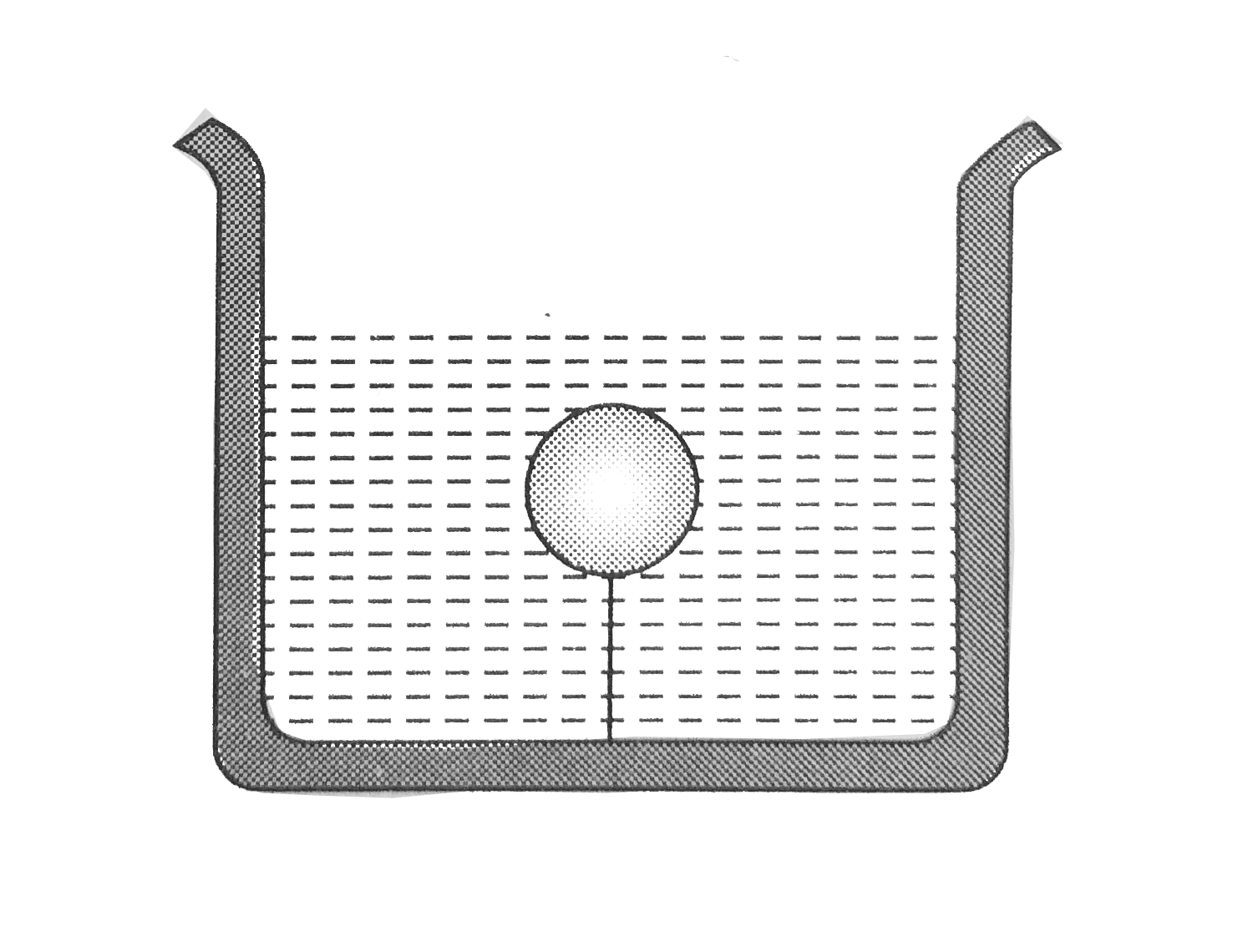
View SolutionAn iceberg of density `900kg//m^(3)` is floating in water of density `1000 kg//m^(3)`. The percentage of volume of ice cube outside the water is
View SolutionA body floats with one-third of its volume outside water and `3//4` of its volume outside another liquid. The density of another liquid is :
View SolutionA body weighs `50 g` in air and `40 g` in water. How much would it weigh in a liquid of specific gravity `1.5`
View SolutionA raft of wood (density`=600kg//m^(3))` of mass `120 kg` floats in water. How much weight can be put on the raft to make it just sink?
View SolutionA vessel contains oil (density `=0.8gm//cm^3`) over mercury (density `=13.6gm cm^3`). A homogeneous sphere floats with half its volume immersed in mercury and the other half in oil. The density of the material of the sphere in `gm//cm^3` is
View SolutionA thin uniform cylindrical shell, closed at both ends, is partially filled with water. It is floating vertically in water in half-submerged state. If `rho_c` is the relative density of the material of the shell with respect to water, then the correct statement is that the shell is
View SolutionA concrete sphere of radius `R` has cavity of radius `r` which is packed with sawdust. The specific gravities of concrete and sawdust are respectively `2.4 and 0.3` for this sphere to float with its entire volume submerged under water. Ratio of mass of concrete to mass of swadust will be
View SolutionA body of density d is counterpoised by Mg of weights of density `d_1` in air of density d. Then the true mass of the body is
View SolutionA jar is filled with two non-mixing liquids 1 and 2 haivng densities `rho_1` and `rho_2` respectively. A solid ball, made of a material of density `rho_3` , is dropped in the jar. It comes to equilibrium in the position shown in the figure. Which of the following is true for `rho_1`, `rho_1` and `rho_3`?
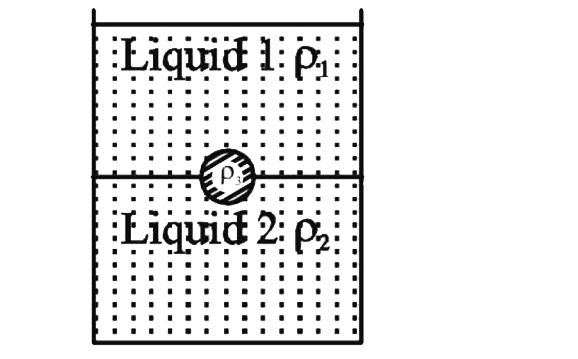
View SolutionA solid is completely immersed in a liquid. The force exerted by the liquid on the solid will
View SolutionA uniform rod of density `rho` is placed in a wide tank containing a liquid of density `rho_0 (rho_0 gt rho)`. The depth of liquid in the tank is half the length of the rod. The rod is in equilibrium, with its lower end resting on the bottom of the tank. In this position the rod makes an angle `theta` with the horizontal.
View SolutionA body is just floating in a liquid (their densities are equal). If the body is slightly pressed down and released it will :
View SolutionA wooden object floats in water kept in as beaker. The object is near a side of the beaker figure. Let `P_1,P_2,P_3` be the pressure at the three points A,B and C of the bottom as shown in the figure.
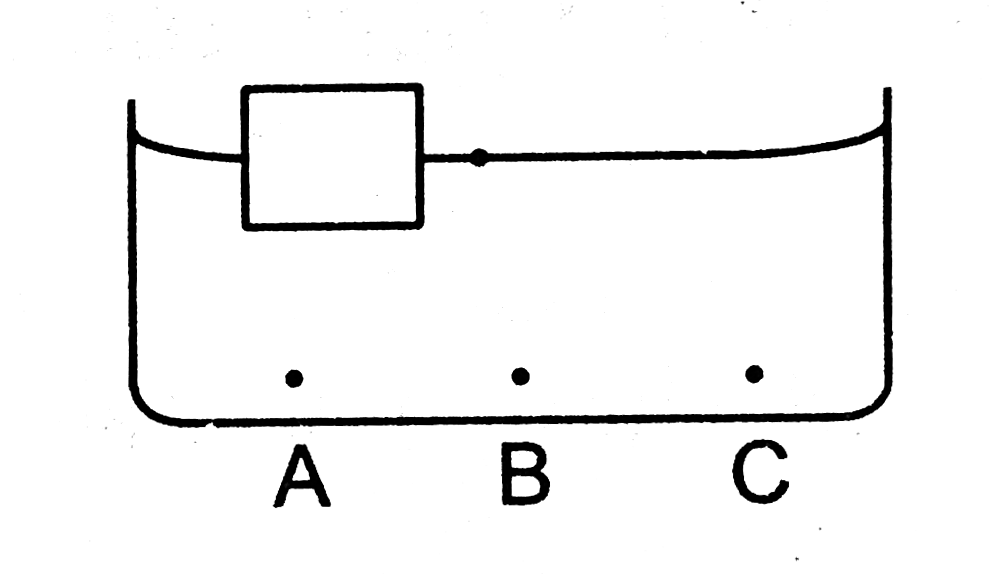
View SolutionA meta cube is plced in an empty vessel. When water is filed in the vessel so that the cubeis completely immersed in the water, the fore on the bottom of the vessel in contact with the cube
View SolutionA cork is submerged in water by a spring attached to the bottom of a bowl. When the bowl is kept in an elevator moving with acceleration downwards, the length of spring.
View SolutionA piece of wood is floating in water kept in a bottle. The bottle is connected to an air pump. Neglect the compressibility of water. When more air is pushed into the bottle from the pump, the piece of wood will float with
View SolutionA piece of wood floats in water kept in a beaker. If the beaker moves with a vertical acceleration `a`, the wood will.
View SolutionA body floats in a liquid contained in a beaker. The whole system as shown falls freely under gravity. The upthrust on the body due to the liquid is
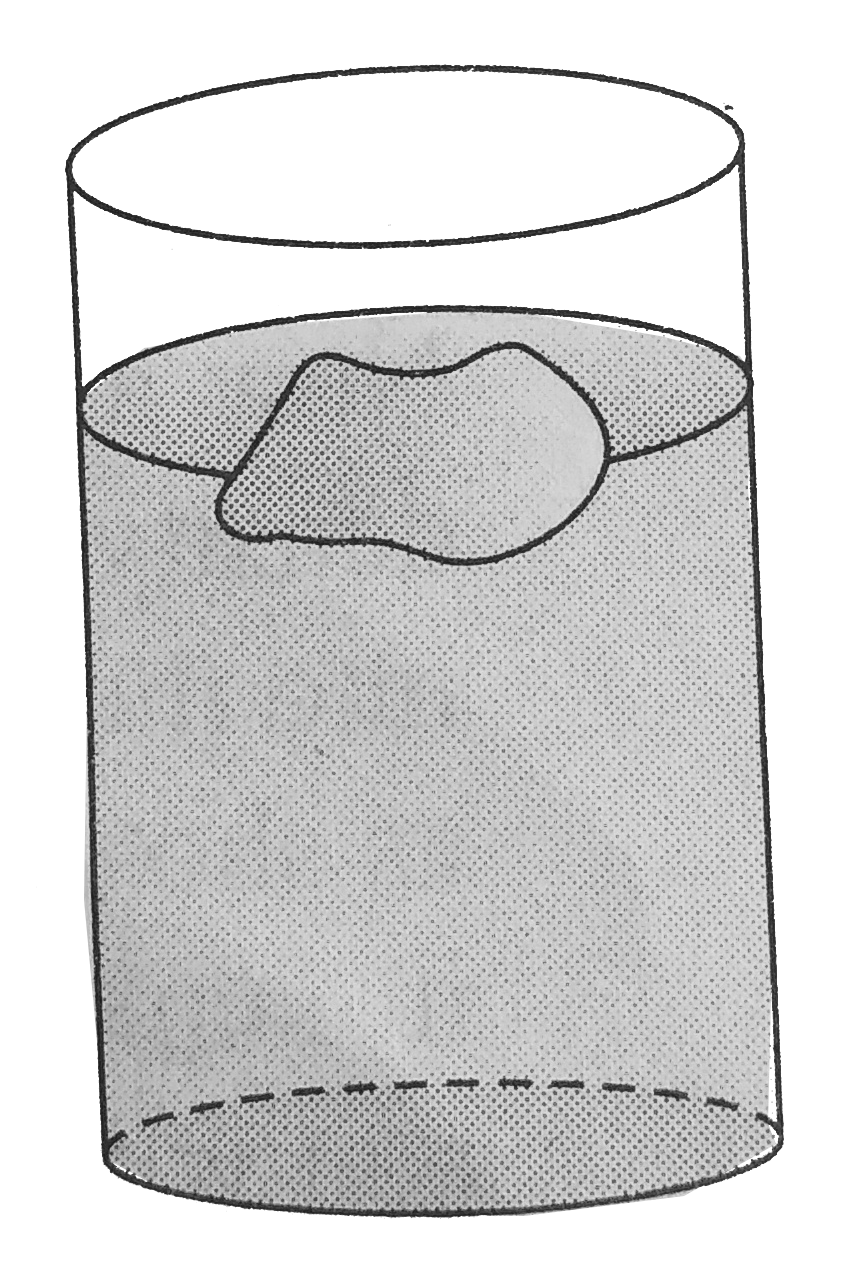
View SolutionA man is carrying a block of a certain substance (of density `1000 kgm^-3`) weighing `1 kg` in his left hand and a bucket filled with water and weighing `10 kg` in his right hand. He drops the block into the bucket. How much load does he carry in his right hand now.
View SolutionA block of ice is floating in a liquid of specific gravity 1.2 contained in the beaker. What will be the effect on the level of liquid in the beaker when the whole ice melts?
View SolutionIce pieces are floating in a beaker `A` containing water and also in a beaker `B` containing miscible liquid of specific gravity `1.2` When ice melts, the level of
View SolutionA boat carrying steel balls is floating on the surface of water in a tank. If the balls are thrown into the tank one by one, how will it affect the level of water ?
View SolutionA candle of diameter `d` is floating on a liquid in a cylindrical container of diameter `D(D lt lt d)` as shown in figure. If is burning at the rate of `2 cm//h` then the top of the candle will :
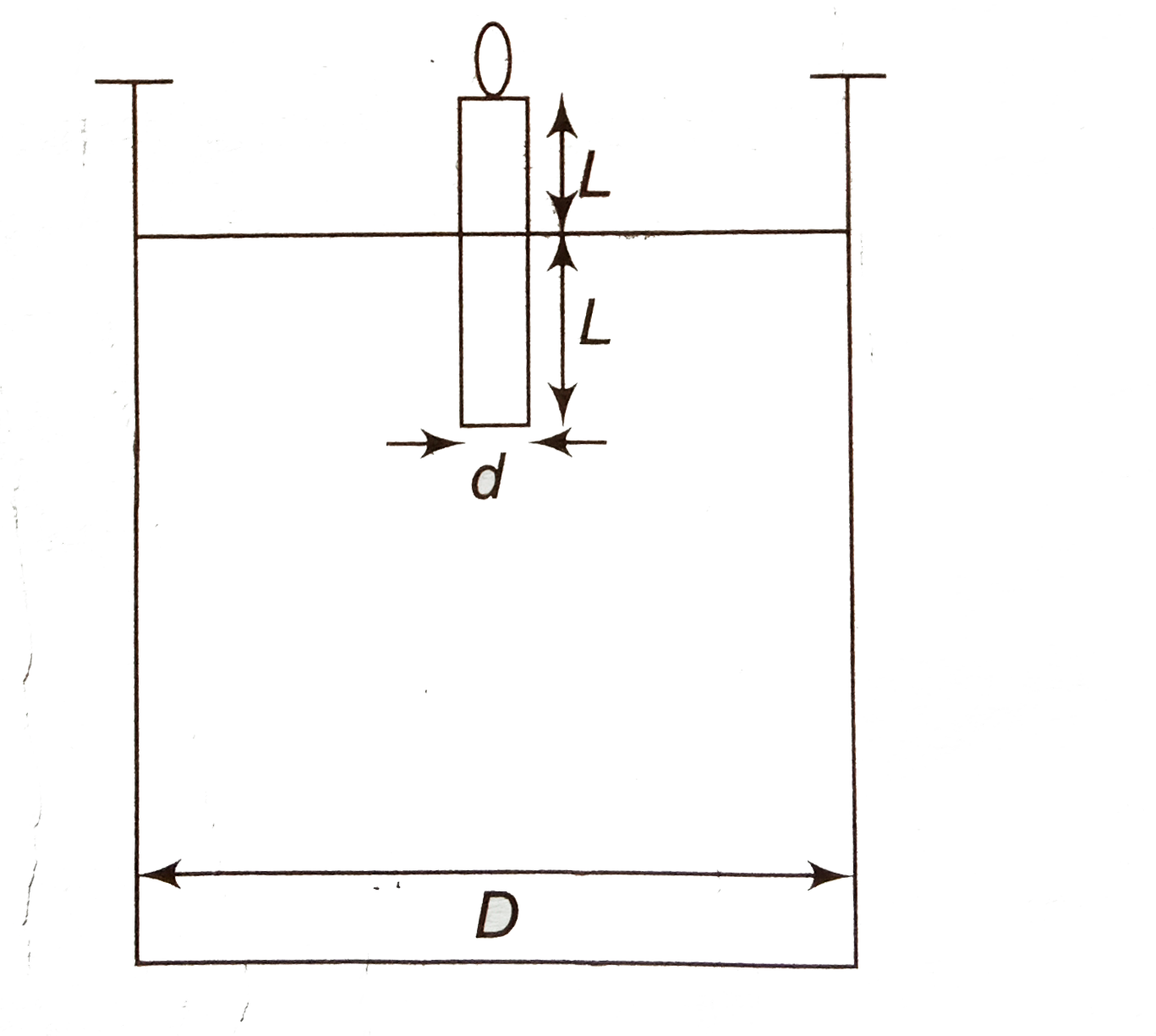
View SolutionA wooden block, with a coin placed on its top, floats in water as shown in figure. The distance l and h are shown here. After some time the coin falls into water. Then
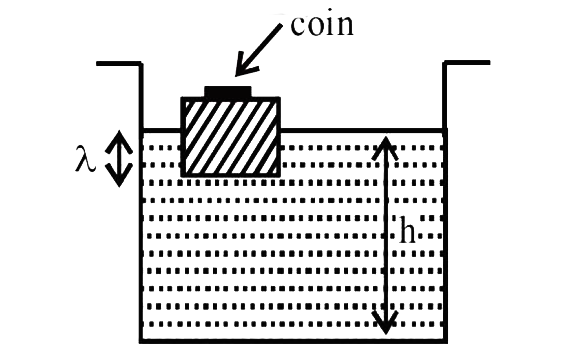
View SolutionA rectangular block of mass `m` and area of cross-section `A` floats in a liquid of density `rho`. If it is given a small vertical displacement from equilibrium, it undergoes oscillation with a time period `T`.
(i) `T prop sqrt(m)`
(ii) `T prop sqrt(rho)`
(iii) `T prop (1)/(sqrt(A))`
(iv) `T prop (1)/(sqrt(rho))`.
View SolutionA spring balance reads `W_(1)` when a ball is suspended from it. A weighing machine reads `W_(2)` when a tank of liquid is kept on it. When the ball is immersed in the liquid, the spring balance reads `W_(3)` and the weighing machine reads `W_(4)`. Then, which of the following are not correct?
View SolutionIn the previous question,
View SolutionA massless conical flask filled with a liquid is kept on a table in a vacuum. The force exerted by the liquid on the base of the flask is `W_1`. The force exerted by the flask on the table is `W_2`.
(i) `W_1 = W_2`
(ii) `W_1 gt W_2`
(iii) `W_1 lt W_2`
(iv)The force exerted by the liquid on the walls of the flask is `(W_1 - W_2)`.
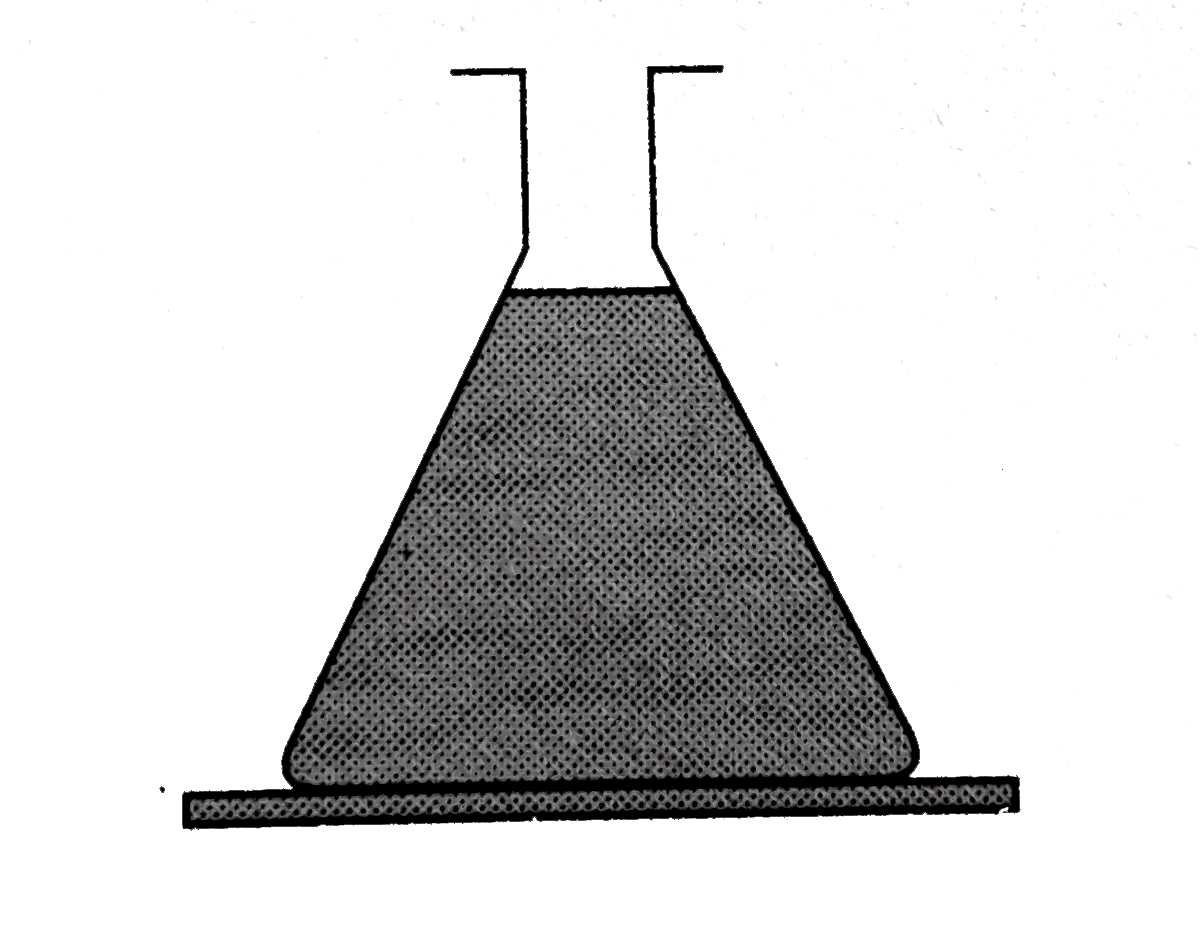 .
.
View SolutionA `20 N` metal block is suspended by a spring balance. A beaker containing some water is placed on a weighing machine which reads `40 N`. The spring balance is now lowered so that the block gets immersed in the water. The spring balance now reads `16 N`. The reading of the weighing machine will be.
View SolutionThe weight of an empty balloon on a spring balance is `W_1`. The weight becomes `W_2` when the balloon is filled with air.Let the weight of the air itself be w.l Neglect the thickness of the balloon when it is filled with air. Also neglect the difference in the density of air insider and outside the balloonn
View SolutionThe weight of a balloon is `W_1` when empty and `W_2` when filled with air. Both are weighed in air by the same sensitive spring balance and under identical conditions.
View SolutionBernoulli's equation is a consequence of conservation of
View SolutionAccording to Bernoulli's equation
`(P)/(rho g) + h + (1)/(2) (v^2)/(g) = "constant"`
The terms `A, B` and `C` are generally called respectively.
View SolutionThe working of an atomizer depends upon
View SolutionThe weight of an aeroplane flying in the air is balanced by.
View SolutionIn a streamline flow,
(i) the speed of a particle always remains same
(ii) the velocity of a particle always remains same
(iii) the kinetic energies of all the particles arriving at a given point are the same
(iv) the momenta of all the particles arriving at a given point are the same.
View SolutionThere is a small hole near the botton of an open tank filled with liquid. The speed of the water ejected does not depend on
View SolutionWater and mercury are filled in towi cylinderical vessels up to same height. Both vesels hve a hole in thewal near the bottom. The velocity of water and mercury coming out of the holes are `v_1 and v_2` respectively.
View SolutionWater enters through end A with a speed `v_1` and leaves through end B with a speed `v_2` of cylindrical tube AB. The tube is always completely filled with water. In case I the tube is horizontal, in case II it vertical with the end A upward and in case III it is vertical with the end B upward. We have `v_1=v_2`for
View SolutionWater is flowing through a long horizontal tube. Let `P_A and P_B` be the pressures at two points A and B of the tube
View SolutionWater is flowign is streamline motion through a tube with its axis horizontal. Consider two points A and B in the tube at the same horizontal level
View SolutionA closed vessel is half filled with water. There is a hole near the top of vessel and air is pumped out from this hole.
View SolutionA liquid flows through a horizontal tube. The velocities of the liquid in the two sections, which have areas of cross section `A_(1)` and `A_(2)` are `v_(1)` and `v_(2)` respectively. The difference in the levels of the liquid in the two vertical tubes is `h`. Then
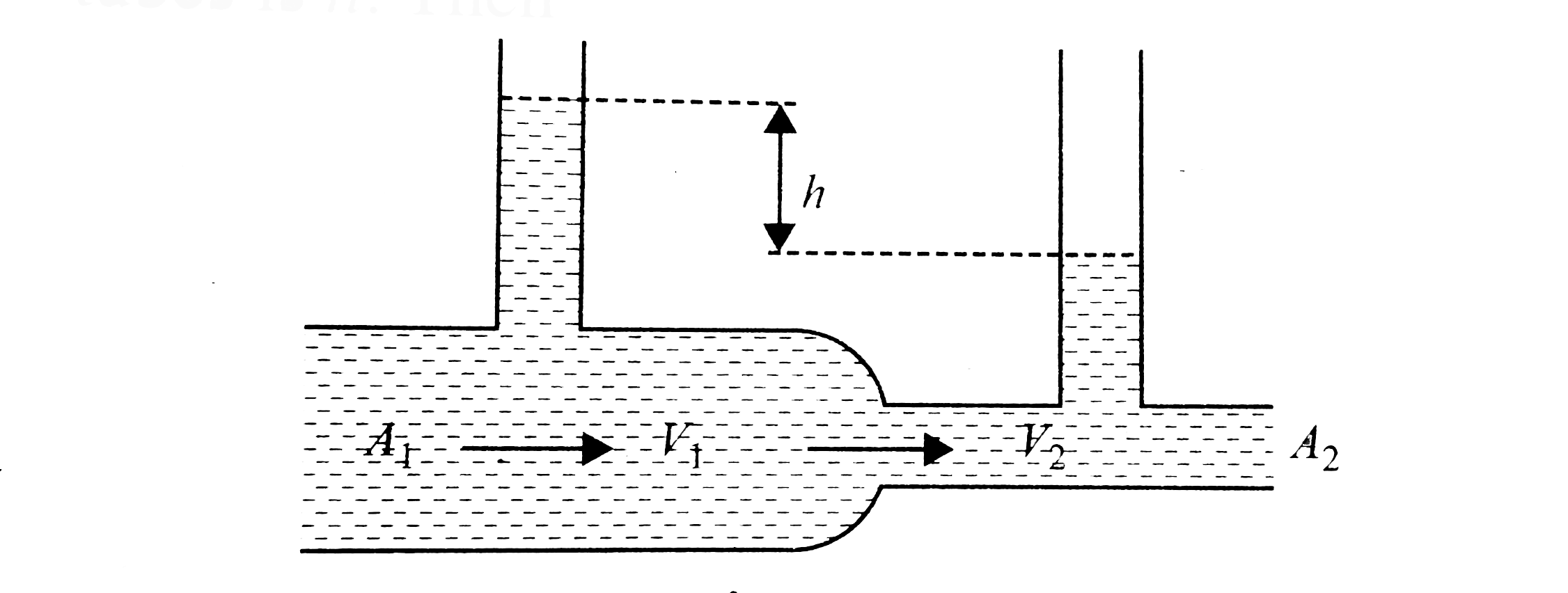
View SolutionThe cylindrical tube of a spray pump has a cross-section of `8 cm^2`, one end of which has `40` fine holes each of area `10^-8 m^2`. If the liquid flows inside the tube with a speed of `0.15 m min^-1`, the speed with which the liquid is ejected through the holes is.
View SolutionThere is a small hole at the bottom of tank filled with water. If total pressure at the bottom is `3 atm(1 atm=10^(5)Nm^(-2))`, then find the velocity of water flowing from hole.
View SolutionA tank which is open at the top, contains a liquid up to a height `H`. A small hole is made in the side of the tank at a distance `y` below the liquid surface. The liquid emerging from the hole lands at a distance `x` from the tank. Choose incorrect option.
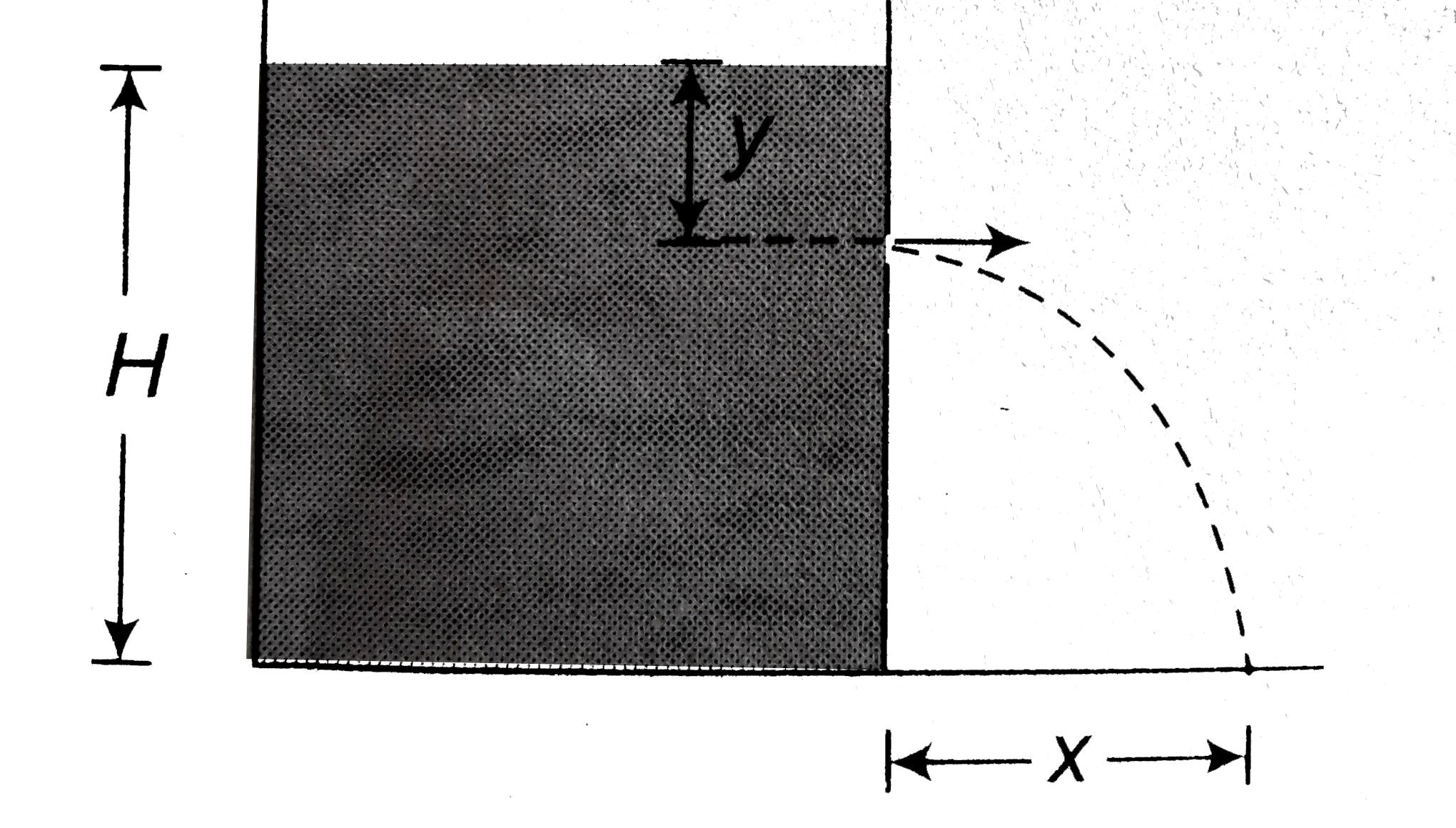 .
.
View SolutionA tank is filled with water up to a height `H`. Water is allowed to come out of a hole `P` in one of the walls at a depth `D` below the surface of water. Express the horizontal distance `x` in terms of `H` and `D`
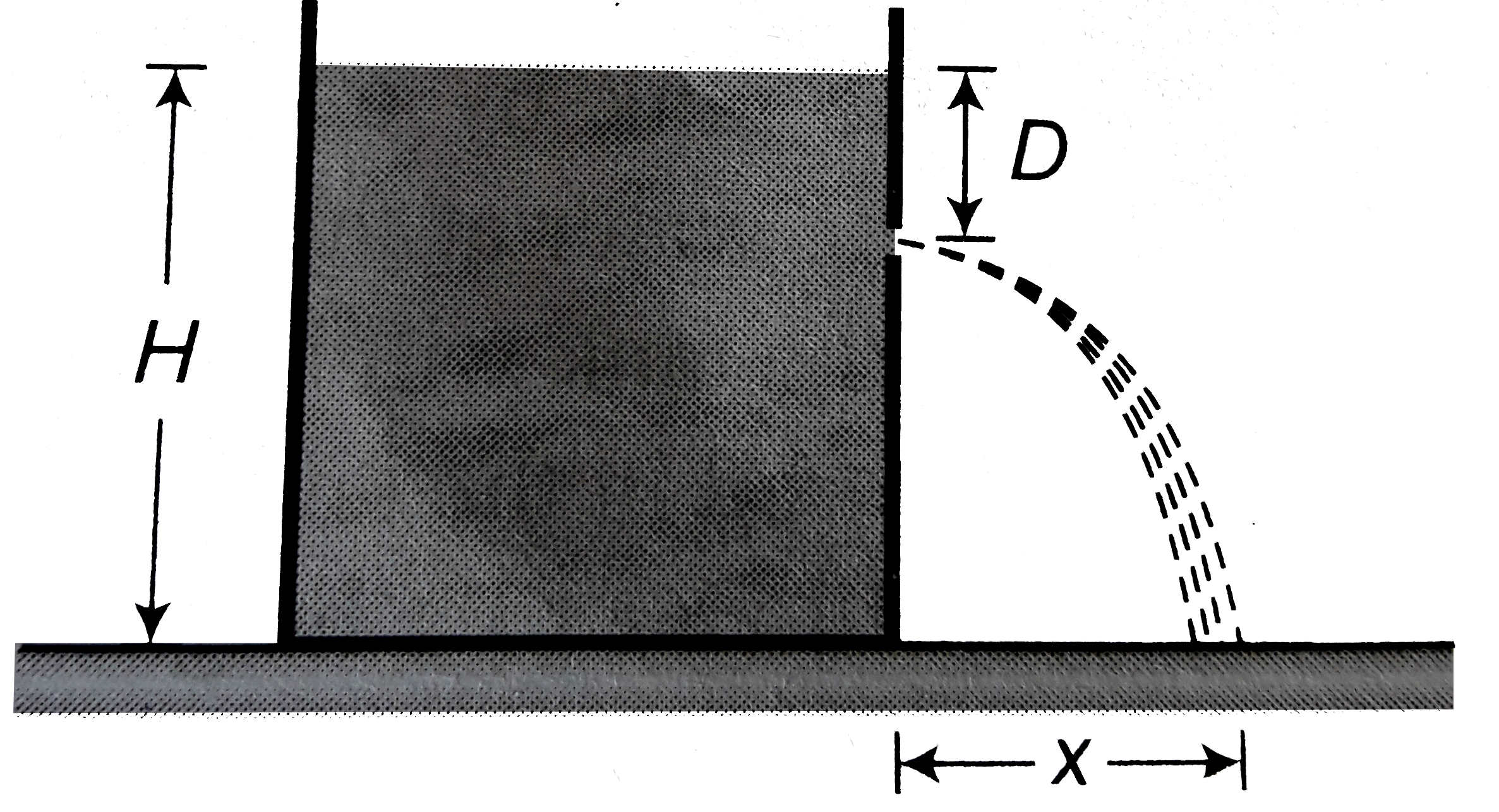 .
.
View SolutionA cylindrical vessel of `90 cm` height is kept filled up to the brim. It has four holes `1,2, 3` and `4` which are, respectively, at heights of `20 cm, 30 cm, 40 cm` and `50 cm` from the horizontal floor `PQ`. The water falling at the maximum horizontal distance from the vessel comes from
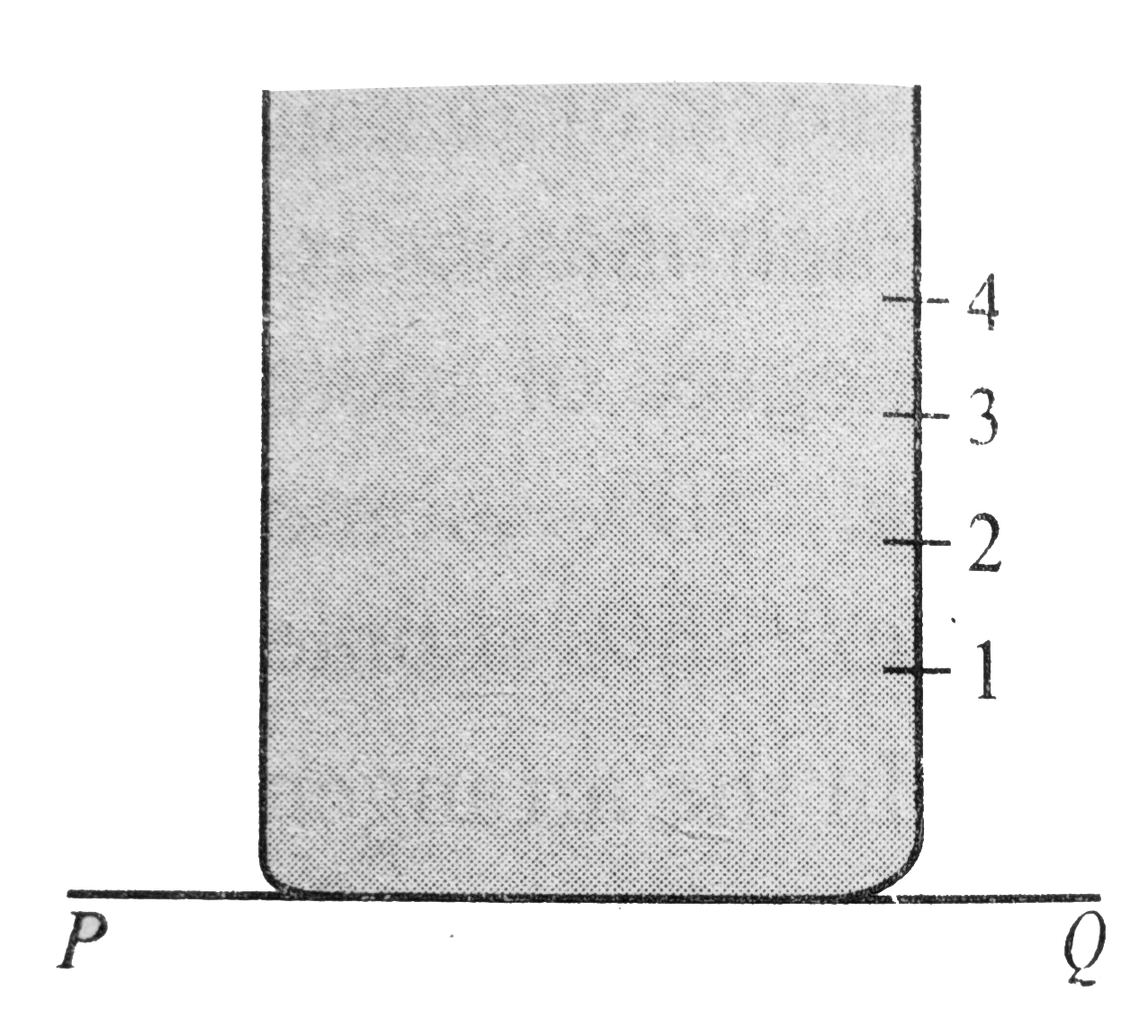
View SolutionA large open tank has two holes in the wall. One is a square hole of side L at a depth y from the top and the other is a circular hole of radius R at a depth 4y from the top. When the tank is completely filled with water, the quantities of water flowing out per second from both holes are the same. Then, R is equal to
View SolutionWater falls from a top, down the streamline
View SolutionWater coming out of the mouth of a tap and falling vertically in streamline flow forms a tapering column, i.e., the area of cross-section of the liquid column decreases as it moves down. Which of the following is the most accurate explanation for this ?
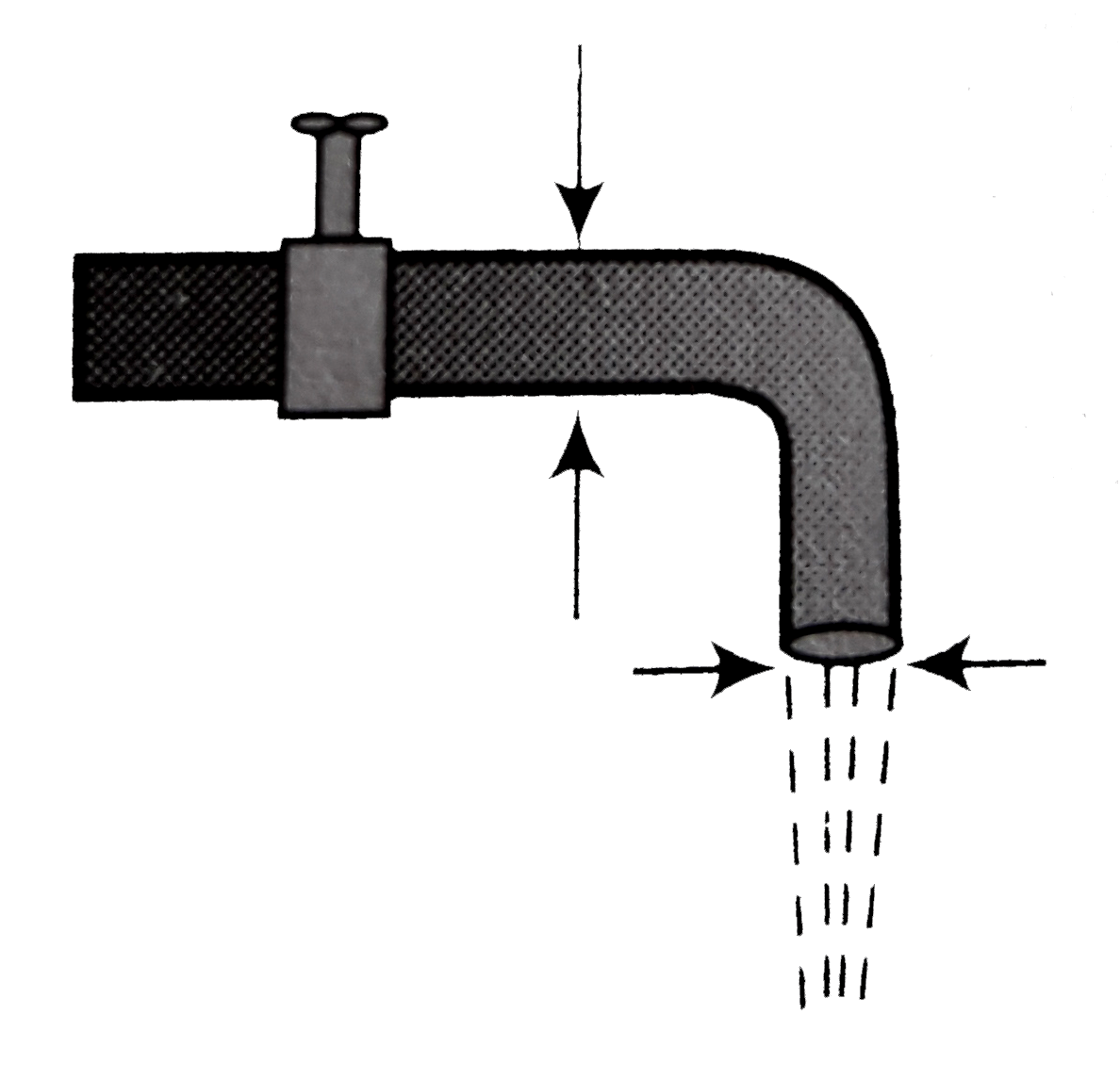 .
.
View SolutionIn the previous question, at the mouth of the tap the area of cross-section is `2.5 cm^2` and the speed of water in `3 m//s`. The area of cross-section of the water column `80 cm` below the tap is.
View SolutionThe tube shown in figure is of uniform cross-section. Liquid flows through it at a constant speed in the direction shown by arrows. Then the liquid exerts on the tube is:
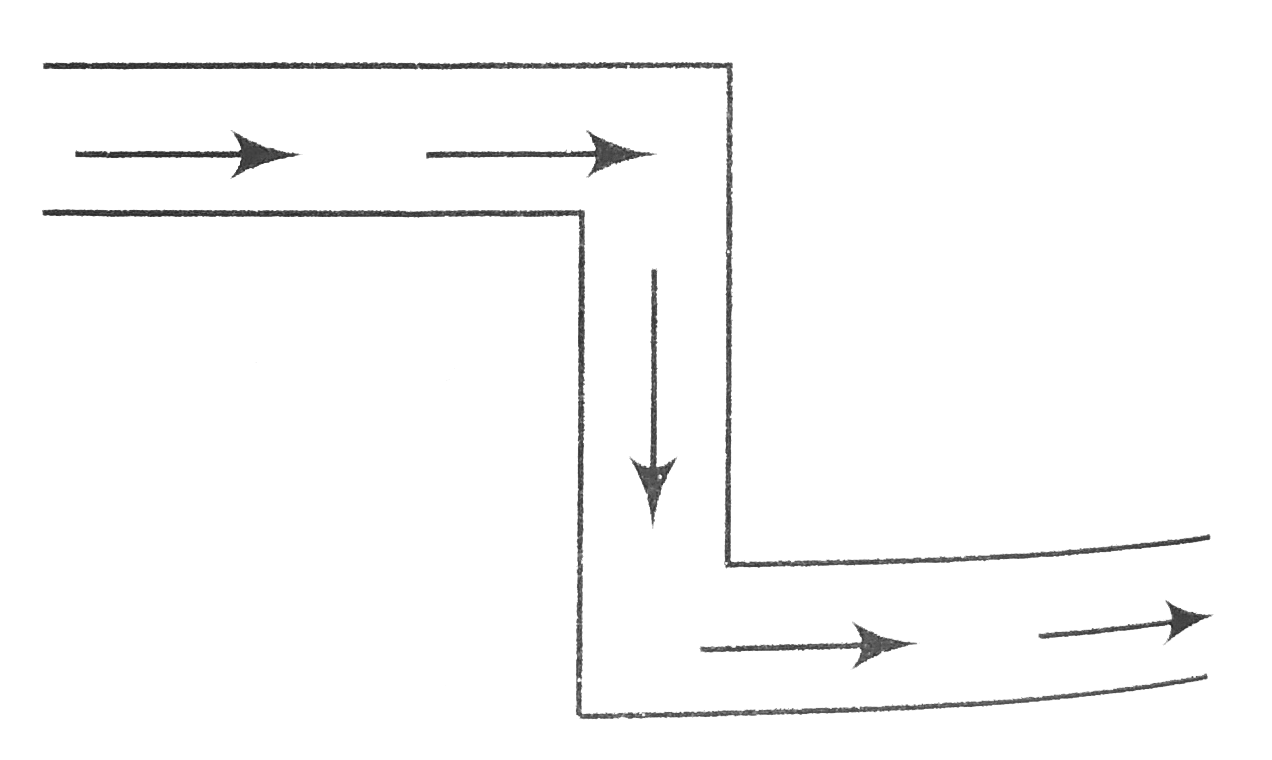
View SolutionIn the figure, an ideal flows through the tube, which is of uniform cross-section. The liquid has velocities `v_A` and `v_B` and pressures `p_A` and `p_B` at points `A` and `B` respectively.
(i) `v_A = v_B`
(ii) `v_B gt v_A` ltbr gt (iii) `p_A = p_B`
(iv) `p_B gt p_A`.
 .
.
View SolutionA liquid is kept in a cylindrical vessel which is being rotated about a vertical axis through the centre of the circular base. If the radius of the vessel is `r` and angular velocity of rotation is `omega`, then the difference in the heights of the liquid at the centre of the vessel and the edge is.
View SolutionA given shaped glass tube having uniform cross-section is filled with water and is mounted on a rotatable shaft as shown in figure. If the tube is rotated with a constant angular velocity `omega` then :
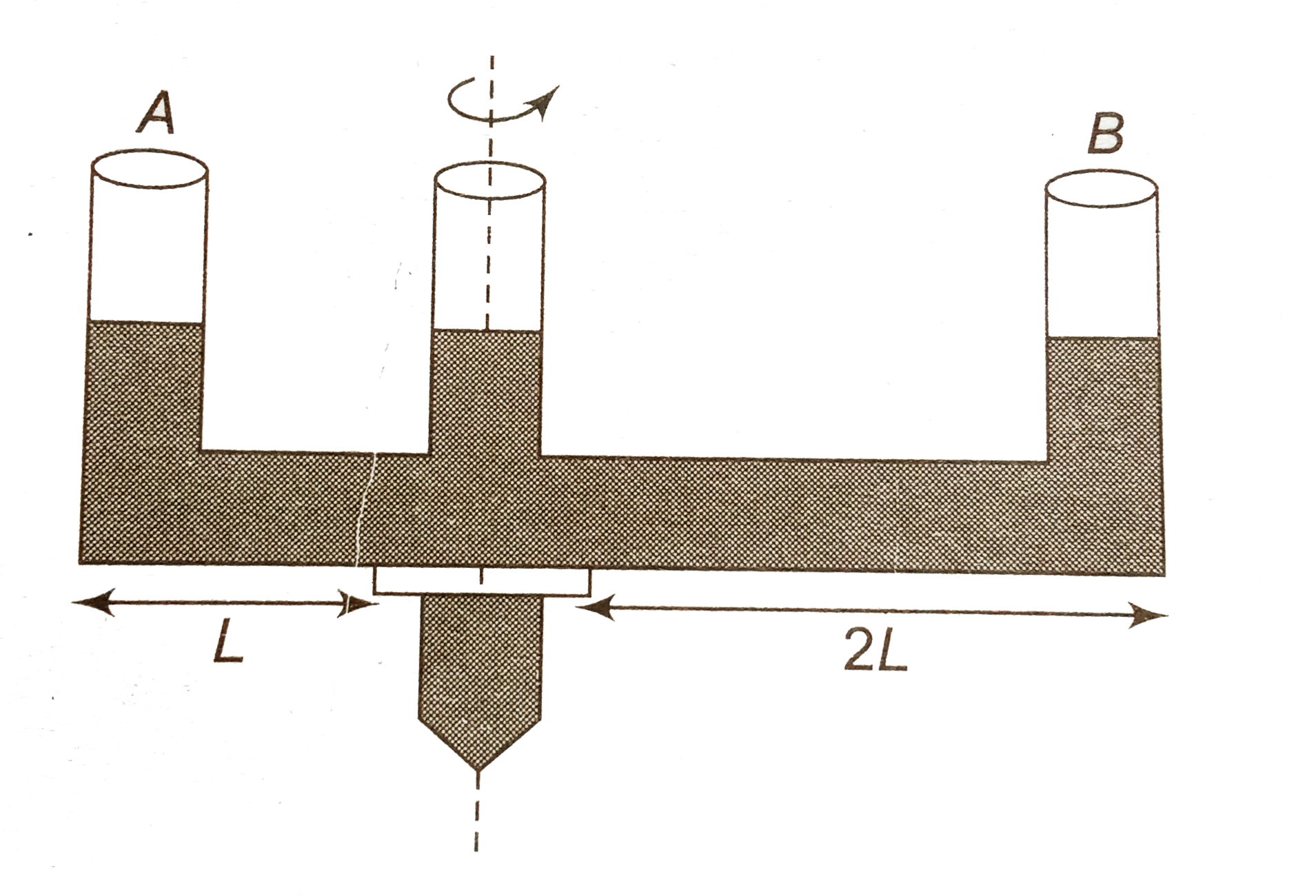
View SolutionWater floows through two identical tubes A and B. A volume `V_0` of water passes through the tube A and `2V_0` through B in a given time. Which of the following may be correct?
View SolutionA liquid of density `rho` comes out with a velocity `v` from a horizontal tube of area of cross-section `A`. The reaction force exerted by the liquid on the tube is `F`. Choose the incorrect option.
View SolutionThere are two identical small holes on the opposite sides of a tank containing a liquid. The tank is open at the top. The difference in height between the two holes is `h`. As the liquid comes out of the two holes. The tank will experience a net horizontal force proportional to.
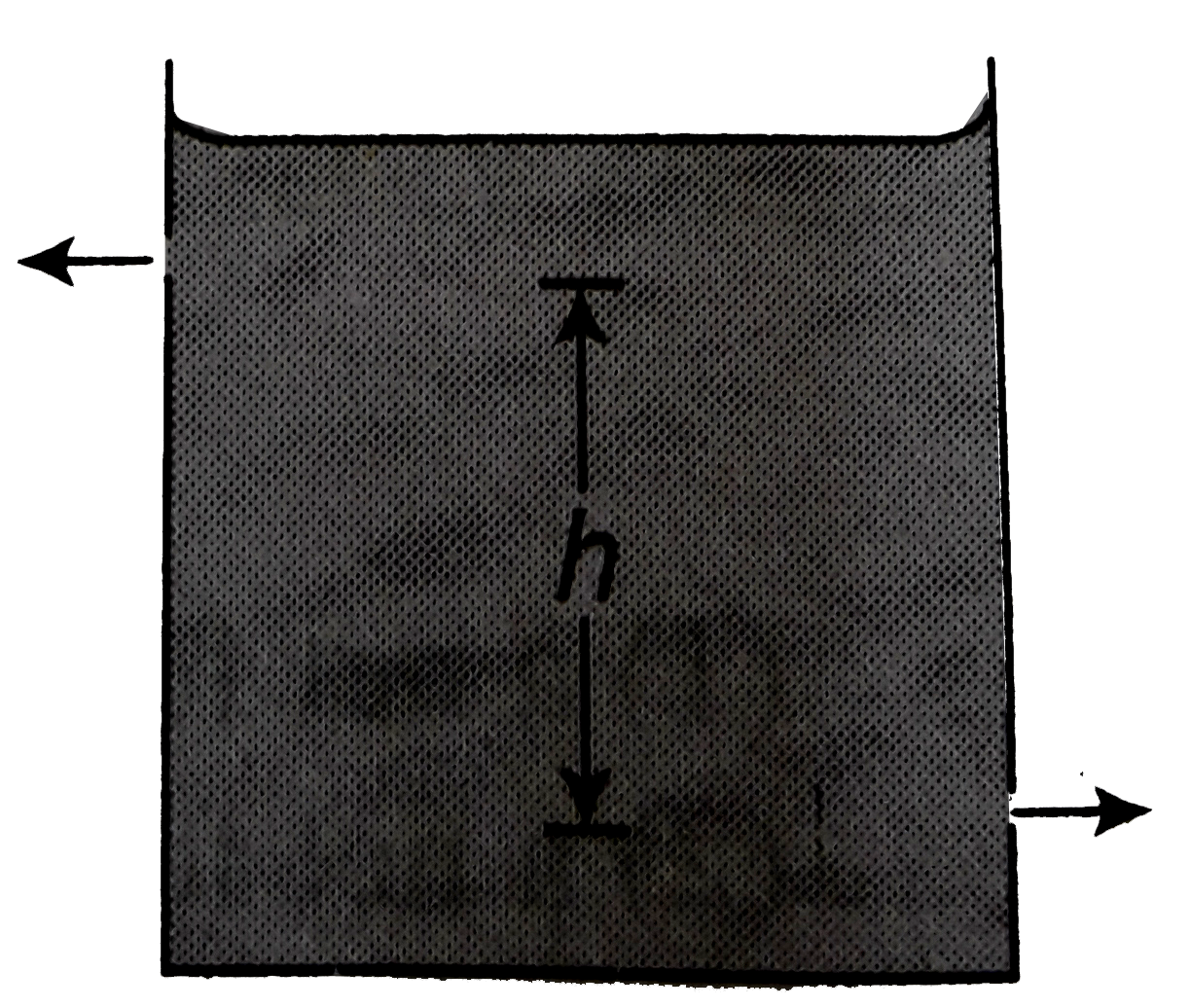 .
.
View SolutionAn engine pumps water continously through a hose. Water leave the hose with a velocity `v` and `m` is the mass per unit length of the Water jet. What is the rate at Which kinetic energy is imparted to water?
View SolutionA cylindrical drum, open at the top, contains `30` litres of water. It drains out through a small opening at the bottom. `10` litres of water comes out in time `t_1`, the next `10`litres in a further time `t_1` and the last `10` litres in a further time `t_3` Then,
View SolutionA large tank is filled with water to a height `H`. A small hole is made at the base of the tank. It takes `T_(1)` time to decrease the height of water to `(H)/(eta) (eta gt 1)`, and it takes `T_(2)` times to take out the rest of water. If `T_(1) = T_(2)`, then the value of `eta` is
View SolutionA cylindrical tank has a hole of `1cm^(2)` in its bottom. If the water is allowed to flow into the tank from a tube above it at the rate of `70cm^(3)//sec`, then the maximum height up to which water can rise in the tank is
View SolutionA large cylindrical tank has a hole of area A at its bottom. Water is oured in the tank by a tube of equal cross sectional area A ejecting water at the speed v.
View SolutionA cylindrical vessel of height 500mm has an orifice (small hole) at its bottom. The orifice is initially closed and water is filled in it up to height H. Now the top is completely sealed with a cap and the orifice at the bottom is opened. Some water comes out from the orifice and the water level in the vessel becomes steady with height of water column being 200mm. Find the fall in height(in mm) of water level due to opening of the orifice.
[Take atmospheric pressure `=1.0xx10^5N//m^2`, density of water=1000kg//m^3` and `g=10m//s^2`. Neglect any effect of surface tension.]
View Solution
Exercises questions and complete solutions for chapter FLUID MECHANICS of CP SINGH PHYSICS (HINGLISH) of Class 11